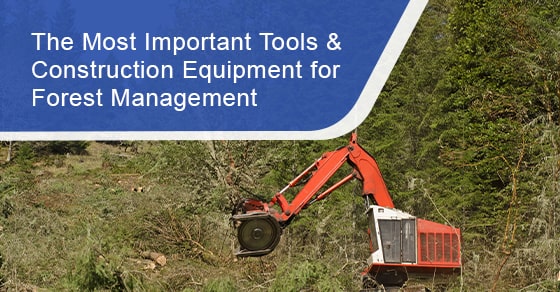
The Most Important Tools & Construction Equipment for Forest Management

Foresters and forest management teams rely on a broad range of tools to complete the work of cutting and processing trees and branches. By understanding the value of these tools and learning how they work, you can make an effective decision about the type of equipment required for your team.
Our experts have decades of experience in forest management and construction equipment. In this new post, we’ll highlight some of the most valuable tools for forestry teams.
Feller Bunchers
Feller bunchers feature a single cutting head capable of gripping several stems and function as a cutting, holding and ground placement device. They usually move via wheels or tracks.
Operators should note that while track systems offer a higher level of stability for cutting work, they move a little more slowly than machines with wheels. That’s why most operators will use track feller bunchers on steep areas and wheel systems on flatter sites. Some feller bunchers also have self-levelling cabs which extend the working slope and provide the operator with greater flexibility in challenging environments.
There are two distinct styles of feller buncher:
1. Drive to tree systems
Drive to tree feller bunchers can drive right to the tree to cut using its carrier-mounted cutting head.
2. Swing boom systems
A swing boom system has a cutter head mounted to a boom which means it doesn’t have to be driven directly to the tree to complete the cutting process.
Feller bunchers have three distinct head options, built for attaching to a boom or directly to the chassis – processing heads, bunching heads and straight felling heads. Processing heads both fell trees and process the remaining trunks. Bunching heads can process multiple stems but cannot process trucks. While straight felling heads cut and fell single stems but cannot process them.
Log Loaders
Forestry teams must often sort and stack logs ready for later processing, and this is why log loaders are so essential within the equipment inventory. Log loaders sort and stack logs and also transport them onto the transport trucks ready to take the material away from the site. Therefore a fully operational log loader is critical to efficient forestry work.
There are three specific styles of log loader:
1. Wheeled
Wheeled log loaders are the best choice for quick movement around the site.
2. Tracked
Tracked loaders provide superior stability over uneven surfaces
3. Trailer mounted
Trailer mounted loaders might be the best choice for affordability but must be pushed or pulled into place.
Mulchers
Mulchers used for forestry work are slightly different from the typical mulcher found in the home yard. Operators use these systems with a tractor or other vehicle which provides horsepower for the mulching process. They use either a fixed tooth rotor system or a swinging hammer for mulching and can process trees of about 40 centimetres in diameter on average.
Stump Grinders
Stump grinders use a rotating disc to remove tree stumps from the ground. There is a broad range of stump grinder sizes, ranging from lawn-mower-style systems to truck-sized grinding systems. The disc comprises a cutting wheel featuring carbide teeth that grind the stump and its connected roots into small chips. Hydraulic cylinders control the cutter head and push it through the stump.
To improve on-site efficiency, teams often attach stump grinders to tractors and excavators. This technique allows them to remove tree roots in seconds and recover the central parts of the tree root for additional processing.
Yarders
Operators use yarders to pull or fly the log to the ground. They consist of a drum, an engine and spar, and there is a range of configurations for specific styles of yarding work. For example, there are both swing yarders and boom yarders. Swing yarders have a wider radius with a swinging boom that can pivot at various angles. Meanwhile, other yarders have a fixed boom system.
The benefit of fixed booms is they have higher towers. So they work more effectively in a deeper landscape that requires control over greater heights.
The chassis for the yarder is usually either tracked or wheeled. There are also skid yarders that feature a flat bottom and allow operators to skid between trees easily.
Harvesters
Harvesters are self-propelled cutting machines that can fell and process stems. Operators use this construction equipment for many forest management applications via wheels or a track. Harvesters operate with a cutting head that fells, delimbs and then cuts the tree to specific lengths for later processing. They can feature either a front or rear cab that is fixed or rotating depending on the harvesting requirements.
Foresters generally use harvesters for processing a single stem tree such as an aspen or a conifer, not for multi-limbed trees.
Delimbers
A delimber is vital to all types of forestry work. They operate via one of three delimbing styles: pull-through, gate and flail.
The pull-through delimber features horizontally-mounted processors. When a loader places a tree into the delimber, a series of knives grip the tree to pull it through the processor. Gate style delimbers feature a steel structure welded into a grid. A grapple skidder processes trees through gates which then break off the limbs. Operators use this equipment alongside a chipper or another system that loads the delimbed stem directly onto the transport truck.
Flail delimbers include rotating drums with chains. The chains break the limbs off the tree when the operator feeds the tree through the drums. These systems can either be self-loaded or connected with a loader for taking the tree through the processor.
Flail delimbers often feature a connected skidder that pulls the tree through and removes the bark. This is often a quality option for companies supplying the pulp and paper marketplace with clean wood.
Turn to Great West Equipment for Forestry Equipment Options
To learn more about construction equipment for forest management, call Great West Equipment at 1-888-492-4365 or contact us here.